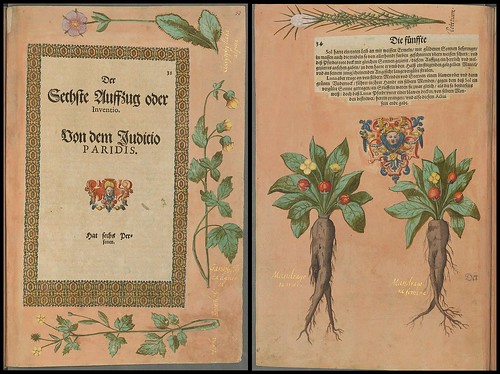




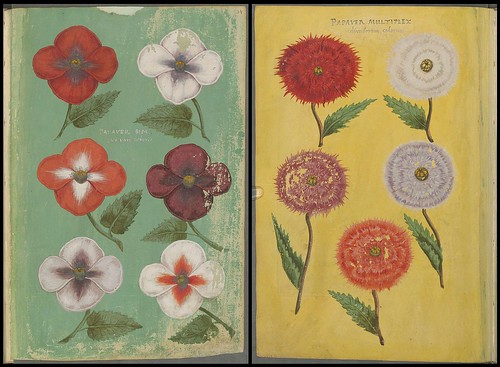

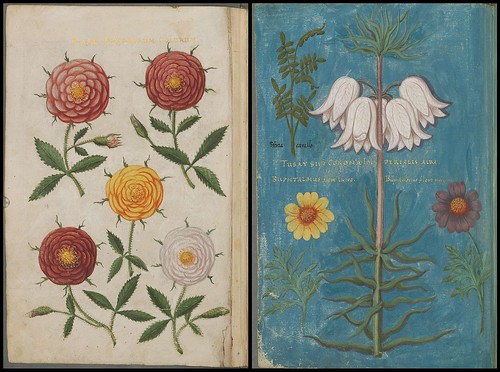
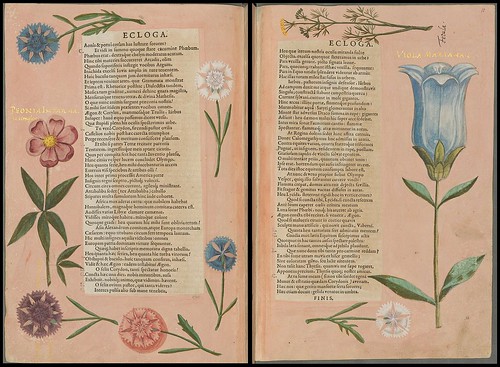
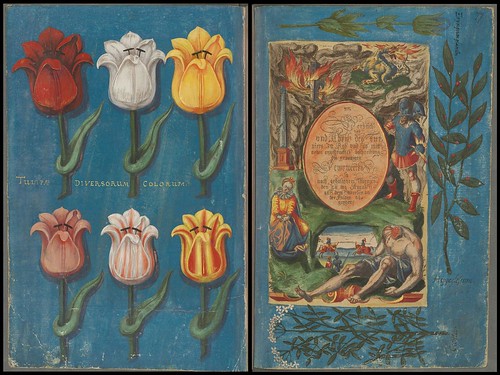

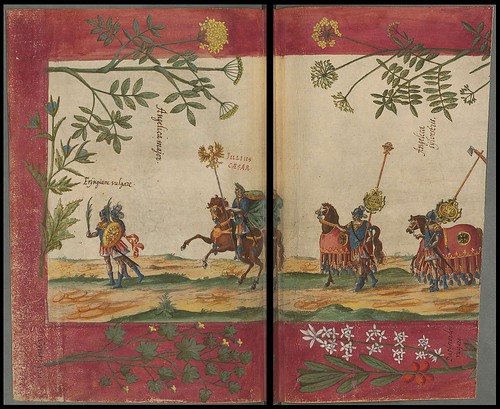

A couple of months ago, we saw an album of hand-coloured allegorical illustrations about a festival held on the occasion of the baptism of Princess Elizabeth of Hessen in 1596.
It turns out that there are three related works held by the Munich State Library. They are: BSB Cod.icon. 340 (we saw last time); BSB Cod.icon. 27(1 {the present botanical album} [translation] and BSB Cod.icon. 27(2 {I haven't had much of a look at this due to the present bandwidth problems, but it seems to be another allegorical festival work relating to an Essen royal parade}.
I *think* the present florilegium was painted onto pages from both of the Essen tournament works, hence making up a kind of scrapbook. The binding bears a date of 1606 and the volume is made up from pages out of the books from 1596 and 1598 by Wilhelm Dilich. The botanical artist is not known and their lush naturalistic watercolour flowers are accompanied by latin taxonomic names.
It was surely an eccentric editorial choice to paint beautiful flowers alongside such striking imagery as beheadings and dragons!
skip to main |
skip to sidebar


analytics
Books~~Illustrations~~Science~~History~~Visual Materia Obscura~~Eclectic Bookart.

Contact | Who?
Recommended Blogs
Blog Archives
Resource Sites
- digital nz
- library of congress
- british library
- library france
- library holland
- library spain
- library portugal
- european library
- library australia
- collections canada
- digital poland
- nypl digital
- botanicus digital
- v&a collections
- britmuseum prints
- smithsonian search
- smithsonian galaxy
- f.a.m.s.i.
- casglu'r tlysau
- rumsey collection
- manuscript catalogue
- digital scriptorium
- cesg manuscripts
- swiss manuscripts
- pecia mss blog
- digital book index
- rare book room
- online exhibitions
- primary sources
- worldcat search
- library directory
- digital librarian
- intute resources
- warburg institute
- lexilogos links
- digiwiki links
- museum blogs
- book arts web
- culture archive
- conservation articles
- art-history timeline
- visual arts
- arts journal
- artcyclopedia
- ukiyo-e
- calligraphy megapage
- penmanship
- woodblock
- coconino
- alchemy website
- health hist. img-banks
- health history links
- history network
- new advent


















7 comments :
this is the most intersting blog online.
Ciao ;^)
"It was surely an eccentric editorial choice to paint beautiful flowers alongside such striking imagery as beheadings and dragons!"
I was hoping you'd be explaining the reason for all those beheadings... not to mention why the first one I noticed seemed to be a bearded lady.
I've come to regard the word allegorical as the get-out-of-jail-free card equivalent in explaining otherwise disturbing or perplexing tropes that manifest in 16th-18th century art.
Those festival books are always replete with mythological and astrological motifs. But I wasn't aware - until now - of any circus sideshow elements such as your bearded lady.
"It's allegorical and evoking circus themes, duh. Don't tell me you haven't seen a bearded lady beheaded at a festival before? It's telling you that if you are too weird, life will be full of pitfalls. So love GOD. And shave off the beard pronto."
(Thanks Roberto!)
I'd better rush off to the barber right away and have that beard removed. (Well, it sure looks to me as though beheading #1 features relatively opulent breasts AND even more opulently bearded head!)
Had I known that the period in question was so full of allegorical and circus themes, maybe I would have done that instead of Czech surrealism. I'd be able to answer just as many questions with an authoritative shrug.
marvelous colors
Just wanted to let you know that this blog is an endless source of fascination/inspiration to me. I have your book too & it's equally delicious.
Many, many thanks,
Leah
Thanks very much for the kind words.
Post a Comment
Comments are all moderated so don't waste your time spamming: they will never show up.
If you include ANY links that aren't pertinent to the blog post or discussion they will be deleted and a rash will break out in your underwear.
Also: please play the ball and not the person.
Note: only a member of this blog may post a comment.